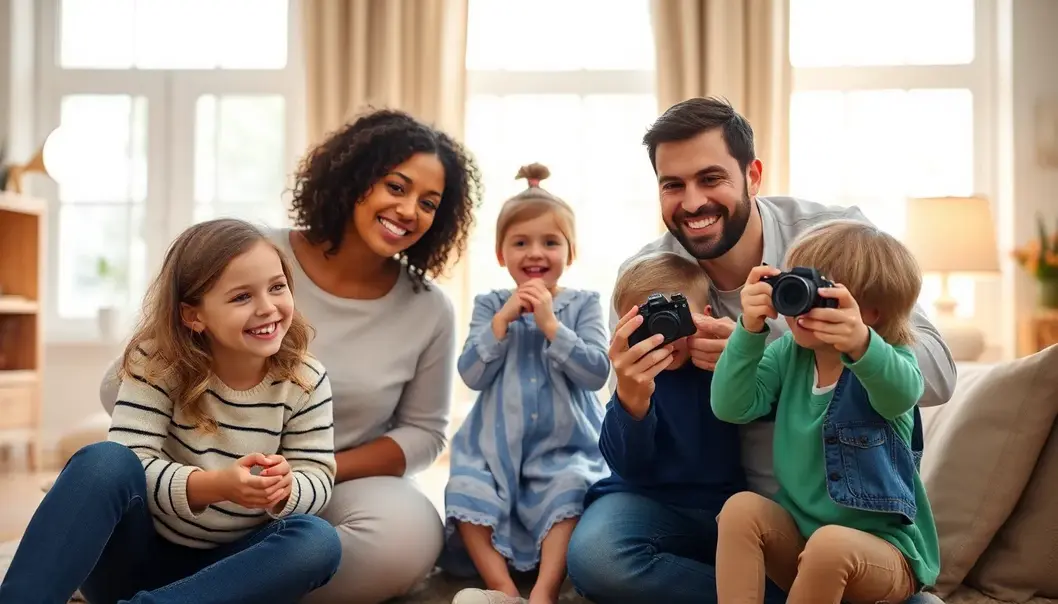Capturing the perfect photo of your children indoors can be both a joyous and a challenging endeavor, especially when you’re a busy parent juggling multiple tasks. Poor lighting is often the biggest hurdle, turning potentially delightful snapshots into dreary keepsakes. Understanding how to leverage indoor lighting can drastically improve your photos, making your memories as bright as the moments themselves. Whether you’re an eager novice or a seasoned family photographer, practical lighting tips can elevate your photography skills, ensuring every precious moment is beautifully preserved, no matter the room or time of day.
Embrace Natural Light: Your Best Friend

Natural light is one of the most powerful tools in your indoor photography arsenal. With its ability to transform ordinary settings into warm, inviting scenes, knowing how to use sunlight effectively can make a significant difference in capturing vibrant photos of your children. Start by positioning your child close to windows or doorways where sunlight streams in. This natural light can create a soft, flattering illumination that artificial sources often struggle to replicate. Place your child at an angle relative to the incoming light to highlight their features without casting harsh shadows.
Timing plays a crucial role in maximizing the benefits of natural light. Early morning and late afternoon provide golden hour lighting, a soft and warm light that adds a magical quality to photos. Midday sunlight can be harsh and direct, but if you’re photographing during this time, look for diffused light. A translucent curtain can soften harsh rays, casting a gentle glow over your subject.
Blinds and curtains aren’t just for blocking light; they can mold it. Adjust these window coverings to control the amount of light entering your space, creating dynamic forms of illumination. Play with the direction and intensity by partially opening the blinds, allowing striped patterns of light and shadow that add depth and interest to your photos.
Reflective surfaces are another element to consider. Mirrors or light-colored walls can bounce natural light around the room, filling in shadows and creating a more evenly lit space. Experiment with different angles and positions to see how light can be harnessed to enhance your photos subtly.
Capturing the essence of your child in photographs is about more than just technique; it’s about preserving precious moments in a vibrant, warm ambiance. Using these simple strategies to harness natural light will bring out the best in your indoor photography, setting a strong foundation for using supplemental lighting, as discussed in the next chapter.
Mastering Flash and Artificial Lighting

As busy parents capturing precious moments indoors, utilizing flash and artificial lighting effectively is vital. The right techniques can make your photos shine while avoiding common pitfalls like harsh shadows or red-eye. When integrating flash, consider bouncing it off a wall or ceiling rather than directing it straight at your subject. This method softens the light, reducing the intensity of shadows and achieving a more natural look.
Red-eye, a frequent issue in indoor photography, results from the flash reflecting off a subject’s retinas. To minimize this, try positioning the flash at a slight angle or using settings that allow a pre-flash to help the pupils contract. If your camera permits, explore adjusting the flash exposure compensation. Lowering it can often yield a more balanced lighting effect.
Incorporating tools like diffusers and reflectors can significantly enhance the warmth and depth of your indoor photos. A diffuser softens the light, dispersing it evenly to diminish harsh lines and create a gentler, more inviting glow. Reflectors can be used to redirect light into shadowy areas, adding dimension without overpowering your subject. A small reflector can highlight your child’s face, capturing their expressions with clarity and warmth.
Balancing mixed light sources—such as combining natural and artificial light—requires a nuanced approach. Experiment with white balance settings to ensure that skin tones appear natural. If your environment has multiple light sources, consider turning off or altering some of them to prevent color conflicts. Sometimes, simply adjusting your shooting angle can help harmonize the various lights for a pleasing composition.
These strategies are especially handy when time is limited, and you need a quick setup for those spontaneous moments. Remember, subtle adjustments can transform your children’s indoor portraits from ordinary to extraordinary.
Final words
Good lighting can be the difference between a dull image and a stunning one. By embracing both natural and artificial light, busy parents can capture extraordinary indoor photos of their children. With these lighting tips, you can ensure that every smile, giggle, and milestone is beautifully lit and perfectly preserved, providing treasured memories for a lifetime.
Unleash your inner photographer today! Download our free guide to mastering indoor photography lighting for amazing family photos.
Learn more: https://www.examplephotographywebsite.com/free-guide
About us
Our company offers a wide range of photography courses and downloadable resources tailored for busy parents who wish to capture high-quality photos of their family. From lighting workshops to personalized coaching sessions, we help transform ordinary snapshots into extraordinary family memories.

